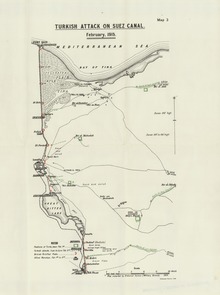Attack on the Suez Canal
1915: Suez Canal
1917: Rafah - Gaza (1) - Gaza (2) - Beersheba - Gaza (3) - El Mughar - Jerusalem
1918: Jericho - Tell 'Asur - Jordan (1) - Jordan (2) - Abu Tellul - Megiddo
The attack on the Suez Canal was carried out by the Ottoman army from January 26, 1915 to February 4, 1915 during the First World War . The British forces managed to repel the attack by Ottoman forces. As a result of the defeat, they withdrew to the Sinai Peninsula . The Turkish commander of Operation Cemal Pascha and the German leadership placed great hopes in the attack to weaken the British Empire .
background
The Suez Canal was an important traffic route in British rule. It was used to bring war goods, merchandise and soldiers from India and the British colonies in Oceania to Europe. A failure of traffic on the canal could be compensated by rail transport through Egypt, but would still have hampered the British war effort. The British military leadership found at the beginning of the war that the canal, defended by around 50,000 soldiers, supported by warships and armored trains, was safe from an Ottoman attack over the Sinai Peninsula.
When the Ottoman Empire entered the war, the leading Young Turkish officer Cemal Pascha had publicly propagated the intention to attack the Suez Canal. On December 6, Cemal arrived in Damascus and tried to put his plan of attack into practice. Cemal assembled an expeditionary force of around 35,000 regular Ottoman soldiers. This was supported by around 9,000 irregulars. Cemal Pasha hoped to spark a pro-Ottoman uprising in Egypt by conquering Ismailia and the Canal. Due to the material inferiority of the Turkish troops, Cemal planned a surprise attack. The logistical planning of the operation was done by the chief of staff of the VII Corps Kress von Kressenstein , who had arrived in Damascus in November 1914 as an officer of the German military mission . In preparation for the offensive, around 10,000 camels were confiscated for transport through the Sinai. From Beersheba to the target point of the Ismailia offensive on the Suez Canal, the Ottoman troops set up a supply depot every 15–20 kilometers. Specially made pontoons were available to cross the canal . On Cemal's orders, the first troops began the march through the desert towards the canal on January 14, 1915.
The British became aware of the Ottomans' preparations for the offensive through aerial reconnaissance and reports from spies and civilians of troop concentrations in Sinai. The covered action of the Ottoman troops, who used the night to march, made it impossible for them to predict the number of attackers and the place of attack. As a result, the British leadership ordered an evacuation of the east bank of the canal and concentrated their troops in defensive positions west of the canal.
course
The British positions came under Turkish artillery fire for the first time on January 26, 1915. On the night of February 2 to 3, 1915, the Ottoman troops launched a general attack focusing on Ismailia. Some soldiers reached the western bank by means of the pontoon bridge and boats. However, the Turkish troops did not succeed in establishing a bridgehead. By the afternoon of February 3, all attacks on the canal had been repulsed and the Turkish artillery fire had been suppressed by the defenders. The Ottoman troops withdrew from the canal on February 4th on the orders of Cemals. At the same time, Cemal Pascha overruled Kress von Kressenstein, who had insisted on continuing the offensive.
consequences
The British leadership decided against pursuing the retreating Ottoman army. The losses on both sides remained small. The British side recorded 162 dead and 130 wounded. The British also claimed that 238 Ottoman war dead and 716 prisoners had been found. Cemal Pasha stated the losses of the expeditionary force as 192 dead, 381 wounded and 727 missing.
